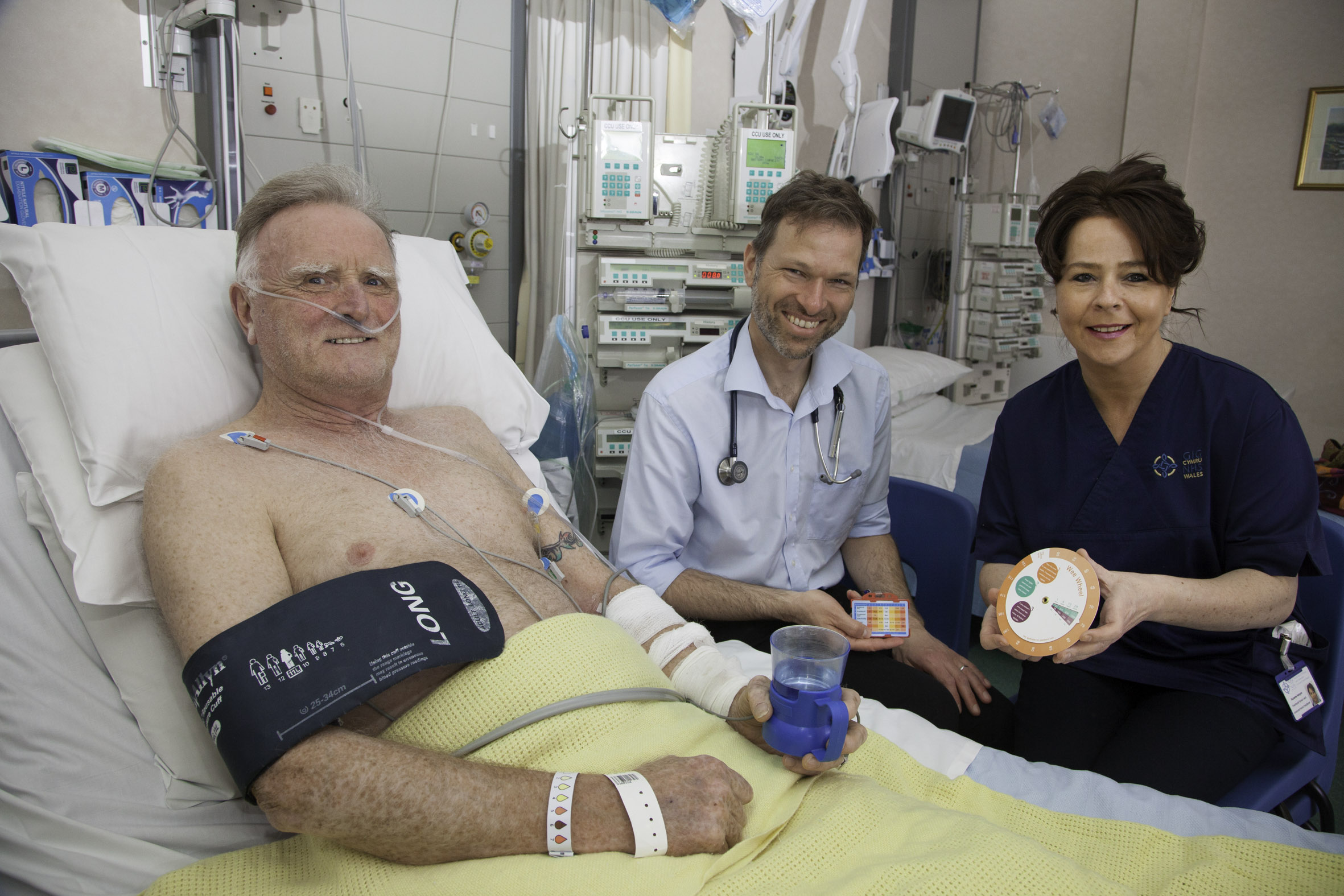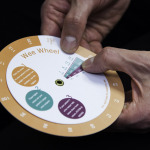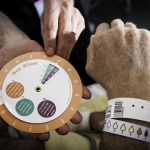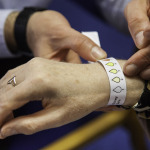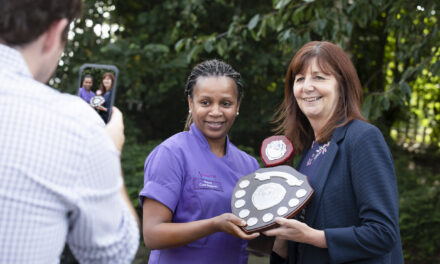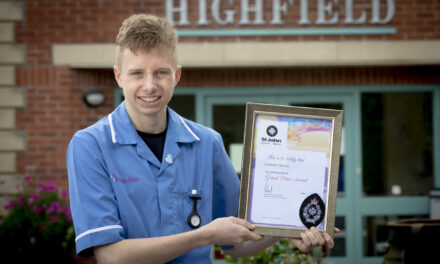A ground-breaking project to help hospital patients monitor their own kidney health is set to be rolled out Wales-wide, thanks to innovative research undertaken in North Wales.
Ysbyty Gwynedd in Bangor has pioneered the use of two potentially life-saving diagnostic tools, led by Betsi Cadawaladr University Health Board consultant Chris Subbe.
The new Kidney Safe Bracelet is designed to encourage patients to check the colour of their own urine, in a move which Dr Subbe says puts them back in the driving seat of their own health care.
The Wee Wheel, issued to medical staff, is a simple but highly effective way forward nurses to monitor the urine output of patients.
Both devices are the result of studies conducted by a team of top health care professionals led by Dr Subbe, a consultant in acute, respiratory and intensive care medicine, and a senior lecturer at Bangor University.
They hugely improve the ability for medical teams to detect Acute Kidney Injury (AKI), a common condition in hospital patients, with one in five emergency cases likely to suffer diminished kidney function.
Treatment is relatively simple but if left undetected AKI can be fatal.
Dr Subbe has now secured funding to roll out the Wee Wheel and Kidney Safe Bracelet across the UK.
He said: “A good outcome hinges on early recognition and timely treatment. It is vital that intervention is administered quickly to minimise the chances of AKI reaching a life-threatening stage.”
Patients may not have been admitted to hospital with a specific kidney condition, but renal complications can be triggered by other ailments while a patient is in hospital. So it is vital urine input and output and urine quality are stringently monitored.
Dr Subbe explained: “Fluid monitoring is crucial, and urine output is a good marker of kidney function.
“The problem is patients often don’t know their renal function is at risk, what it means for their health or what they should look out for.
“By agreeing to wear the Kidney Safe Bracelet they have a constant visual aid at hand reminding them of one of the most important symptoms to be aware of – a change in the colour of their urine.
“The bracelets actively involve a patient in the process of looking after their own kidneys.
“Sometimes people can feel helpless in hospital, as if everything is taking place around them but these bracelets provide an extremely positive way for them to monitor their condition and are a valuable extra aid to the medical teams.”
The bracelets display a band of seven colours, with the darker end of the spectrum being the danger zone and the lighter colours healthy.
Dr Subbe said: “We ask patients to check the colour of their urine each time they go to the toilet and to alert a nurse immediately if their urine colour is verging towards the darker shades on the bracelet chart.
“The very fact that a patient is wearing a Kidney Safe Bracelet is also a reminder for nurses to check with them that they have been monitoring their urine colour.
“It is such a simple technique but it can make a massive difference in preventing serious renal complications.”
Heart patient Mr John Roose, 65, of Pentrefelin, Amlwch, said he was happy to trial the Kidney Safe Bracelet and would welcome its introduction in hospitals across Wales. He said it was unobtrusive, comfortable and no trouble to wear.
The former power worker who suffered a heart attack while on his way to the shops to buy milk, added: “I’m a firm believer in preventative medicine.
“It is better to be able to detect a condition early and stop it in its tracks, than have to deal with it once it has really taken hold. The bracelet is easy to wear and could help save lives.”
The Wee Wheel is a specially designed circular chart which is issued to nursing staff on hospital wards, enabling them to speedily match a patient’s urine output with their body weight.
Dr Subbe said: “One person’s urine output will vary from another’s according to their weight. A mathematical equation will tell us what is healthy and what is not, but nurses do not always have the time to do the maths on a busy ward.
“The Wee Wheel does the sums for them in an instant. They simply turn the wheel to the patient’s body weight and it will show them what the healthy level of urine output is for a person of that weight.
“If the patient’s urine output is too low or too high we are alerted to it right away and appropriate treatment can be arranged.”
Dr Subbe was part of the team behind the introduction in 2012 of National Early Warning Score (NEWS) cards across Wales.
The at-a-glance cards, of a similar size to a credit card, enable medical staff to quickly score patients against known risk factors, paving the way for earlier detection and a speedier response to life-threatening conditions such as sepsis, which causes 37,000 deaths a year in the UK.
Sepsis can be difficult to detect but the NEWS cards – produced at a cost of just a few pence each – remind medical teams which symptoms to be on the lookout for.
Each symptom is allocated a score on the card. Doctors, nurses, and other clinicians are then quickly able to add up a tally of points for each patient they treat. Anyone with a high score is immediately referred for further investigation.
The move has been credited with helping to instigate a 20 per cent reduction in mortality rates among high risk patients.
Dr Subbe said: “The cards did not make the difference alone, but they provided a constant reminder for clinicians of symptoms to be on the alert for. This provided a framework for quicker detection of some conditions and more prompt action to be taken.”
The NEWS cards proved such a success that they are now used in hospitals all over the world.
Dr Subbe and his team are confident the Wee Wheel and Kidney-Safe Bracelets will also be adopted across the UK – and perhaps even globally.
Ysbyty Gwynedd ward sister, Suzanne Kenyon, who has been ward lead for 18 months on the coronary care unit said both tools were warmly welcomed by the ward staff.
She said: “These are such simple yet ingenious ideas. The Wee Wheel is so easy for us to use that in the short time since it was first introduced it has become an essential guide for us when assessing the urine output of patients.
“The bracelets are practical for patients to wear and use. They also give them the impetus and confidence to alert us the moment they think anything is wrong with the colour of their urine.”
The Wee Wheel was designed by a team from the Helen Hamlyn Centre for Design at the Royal college of Art, London. The centre undertakes design and research projects in co-operation with industry and public bodies, to help improve people’s lives.
Dr Subbe said: “We knew what our goal was but we needed professional designers to create it. We wanted the wheel to be as simple as possible to use but consistent, reliable and effective. The Helen Hamlyn Centre helped us achieve that.”
Originally from Germany, where he qualified in medicine, Dr Subbe moved to North Wales on meeting his wife who is from Anglesey.
He has been based at Ysbyty Gwynedd for four years, having previously worked at Wrexham Maelor Hospital.

